Guide Time: What makes the best women’s wave pool surfwear?
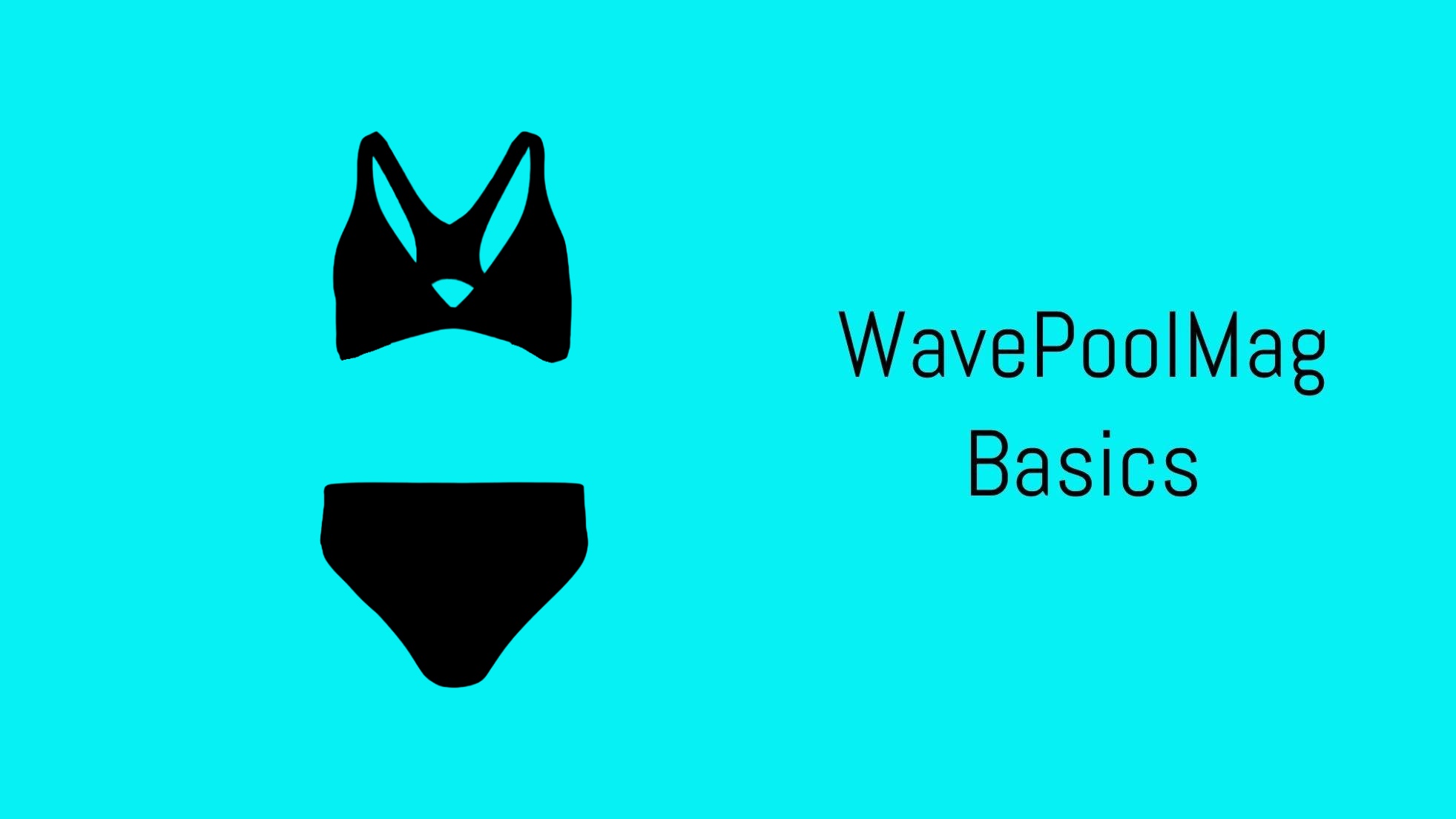
With a wide range of swimsuit choices for pool and ocean pursuits, it’s easy to take lightweight, quick-drying, and comfy swimwear for granted. Sure, modern suits inherently collide with the male gaze and carry considerable cultural baggage around expectations of women’s bodies, sexuality, and athletic ability.
But in terms of function, fashion, and purpose-made pieces? Swimwear has come a long way to maximize comfort, performance, and yes, style. There are so many options that it’s now possible to pick the perfect swimwear not only for surfing but for surfing in wave pools: a niche within a niche within, yes, another niche. From the type of material to the width of the straps, it’s possible to optimize comfort and fit down to the feel, fit, and look.
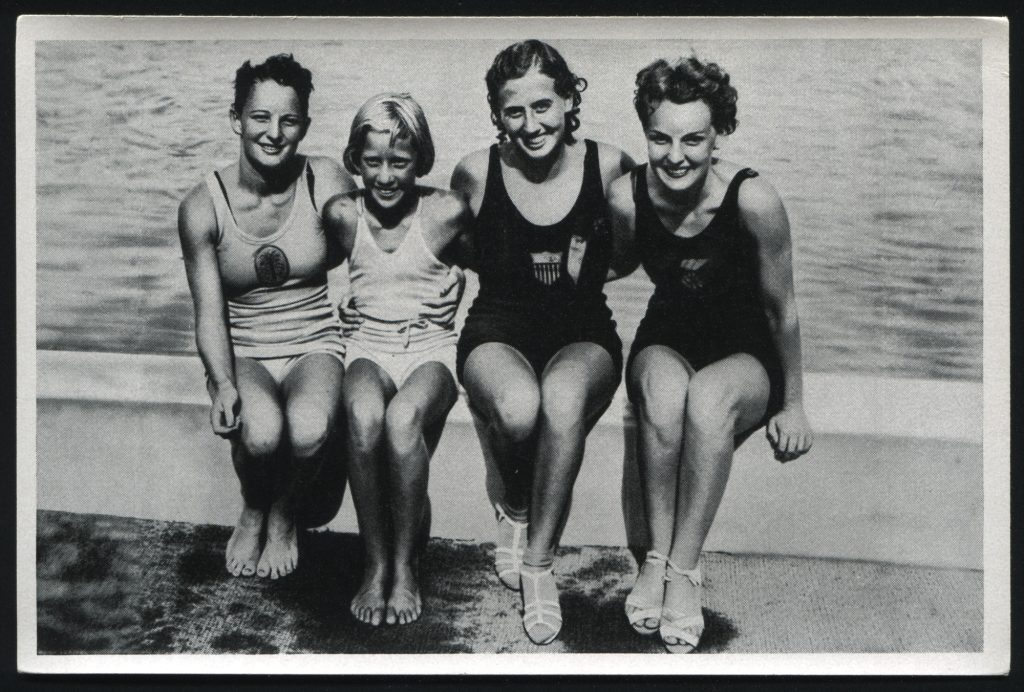
BB (Before Bikinis)
Before your guide to women’s wave pool-wear, consider where women’s swimwear has been. From the 18th century to the early 20th, women’s swim outfits in Europe were designed around modesty – not practicality. So-called swimwear included everything from linen robes to cotton undergarments, plus wool stockings, slippers, and bonnets. Sometimes weights were even sewn into hems to ensure that no part of a woman’s body would inadvertently be exposed.
In Polynesia, meanwhile, European mores had yet to police women’s bodies. People of all ages enjoyed being in the water clothing-free. At the most, women might have worn a lightweight sarong around their waists while riding the warm-water waves. That is, until the missionaries arrived.
According to Jim Kempton’s Women in Waves, after Europeans landed in the South Pacific in the late 1770s, sartorial expectations changed considerably. By the end of the 19th century, women were mandated to wear body-covering wool outfits in the water. The material could take on up to 40 pounds, which wasn’t just cumbersome, but dangerous. Some women drowned under the sheer weight of their water-logged garments.
It wasn’t until women began swimming competitively that the design of their water-bound regalia became geared toward actual movement. Women still faced literal policing at the beach – in 1907, champion swimmer Annette Kellerman was charged with indecent exposure for wearing a unitard-like piece that left her arms, legs, and neck uncovered – but at least swimwear (and cultural sensibilities) were moving in a more performance-minded direction.

Bonjour au bikini
Leave it to French ingenuity and culture to create swimwear that left modesty in the Puritan dust. In 1946, French designer Louis Réard debuted a new, two-piece swim outfit he named the bikini, after a Pacific atoll where the U.S. has been conducting nuclear tests.
Despite this inauspicious nomenclature, the skimpy swimwear was a hit on the continental coasts. It took the U.S. longer to embrace the look, but within a decade or two, the bodycon beachwear finally arrived on Yankee shores. By then, materials had improved for aquatic attire: nylon was now ubiquitous in men’s and women’s swimsuits and both comfort and style could reign.

Modern design: considerations for wave pools
There are, roughly speaking, two types of swimwear for women: poolside suits for lounging, looking good, and not making sudden moves. (Read: my super-beautiful, mostly-useless Rio-made bikini with a triangle top and barely-there bottom. I’ve worn it just once since – because, obviously, cannonballs.)
Then there’s the kind of suit made for women who move. These stay put under set waves, last for years, and fit like a glove. In wave pools, performance features are crucial because there are more waves per session than in the ocean and more contact with whitewater – whether you’re a beginner or in training. And finally, why sacrifice fashion for function?
Behold, the key features to consider for women’s wave pool swimwear.
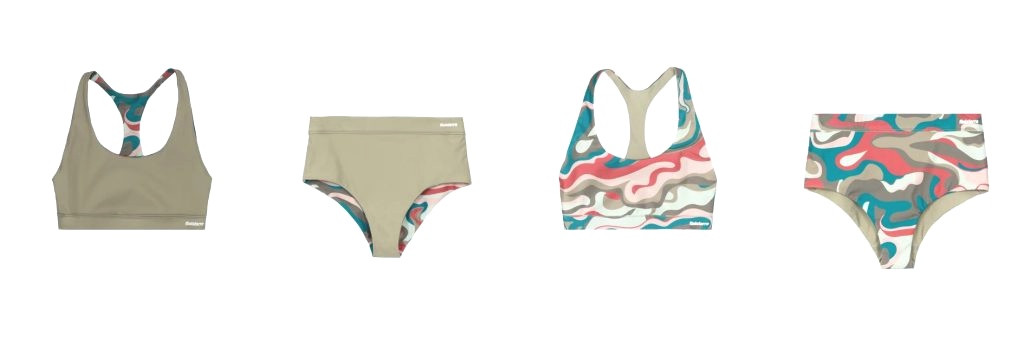
High-tech fabrics that breath and stretch make the whole wave pool surf suit choice much easier. Finisterre Women’s Anella Reversible Crop Bikini Top and Women’s Anella Reversible High Waist Bikini Pant
Material
The first consideration is material. Most swimsuit brands are made with a mix of nylon (a durable plastic fabric derived from petroleum) and spandex (a stretchy synthetic fabric derived from polyurethane). Spandex is synonymous with lycra and elastane: they’re all stretchy, form-fitting, and durable.
Some swimsuit brands offer double-layered nylon-spandex blends designed for compression. These should fit like a second skin – firm but not restrictive. Supportive but not suffocating. Look for words like “compression” and “four-way stretch.” Think gym wear for the water: cute, functional, and goes the distance. In the US, women-owned brand Left on Friday is a newer arrival with a buttery, compressive material and styles that look and feel good on every body.
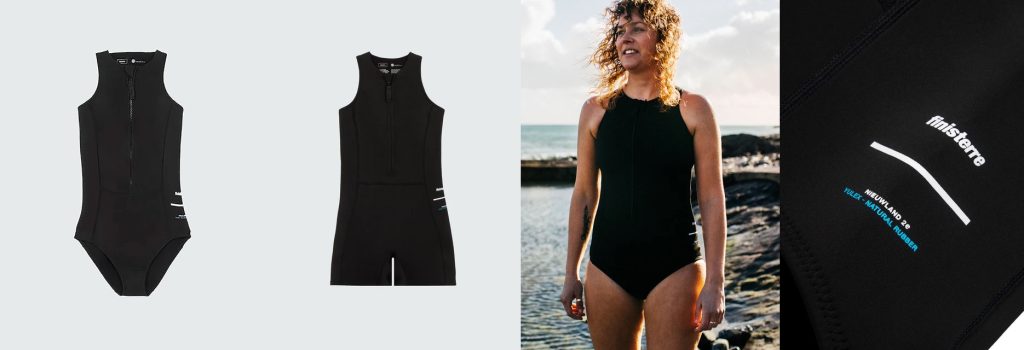
The Wave in Bristol carries a wide selection of women’s surfwear offerings in thin neoprene including Finisterre’s Women’s Nieuwland 2e Yulex® Swimsuit and Women’s Nieuwland 2e Yulex® Sleeveless Shorty
According to Freya Morris, buyer for The Wave Bristol’s shop, some of the high-demand products there are Rip Curl’s Run Surf Swim collection (tagline: “For women who move.”). The line features mix-and match sets of sports-bra-style halters, bike shorts, and leggings, all in materials that range for four-way stretch to DWR, which keeps fabric dryer and extends its life.
That versatility and comfort is part of what makes them so popular.
“They give you ease of movement that you need for surfing when you’re popping up, but also you don’t just have to wear them in the pool.” Yoga, pre-surf warm-ups, beach runs – these sets feature thicker, durable fabric and do it all.
Finally, said Morris, a lot of visitors to The Wave Bristol look for eco-conscious brands.
“ It’s always good to look for something that’s made from regenerated polyester, or anything like that. Something that’s got an eco credential [like Finisterre],” she said. “You can get stuff that’s made out of recycled polyester, or is even recycled from other swimwear.”

Warmth and protection
Nylon-spandex blends are great for hot days and made for streamlined movement, but as soon as a breeze comes up, you might want something with more warmth. That’s where neoprene comes in – not wetsuits, but one-mil pull-ons that are cut like bathing suits.
“Finisterre does one, and so does Rip Curl,” said Morris. “It’s got that little bit of extra warmth so the wind’s blowing, you don’t get as cold.
Also, said Morris, these suits protect skin from friction on the board.
“The wax isn’t rubbing on your chest and your skin as much, just because there’s slight thickness to the swimwear,” she said. “It feels like more than just a swimsuit.”
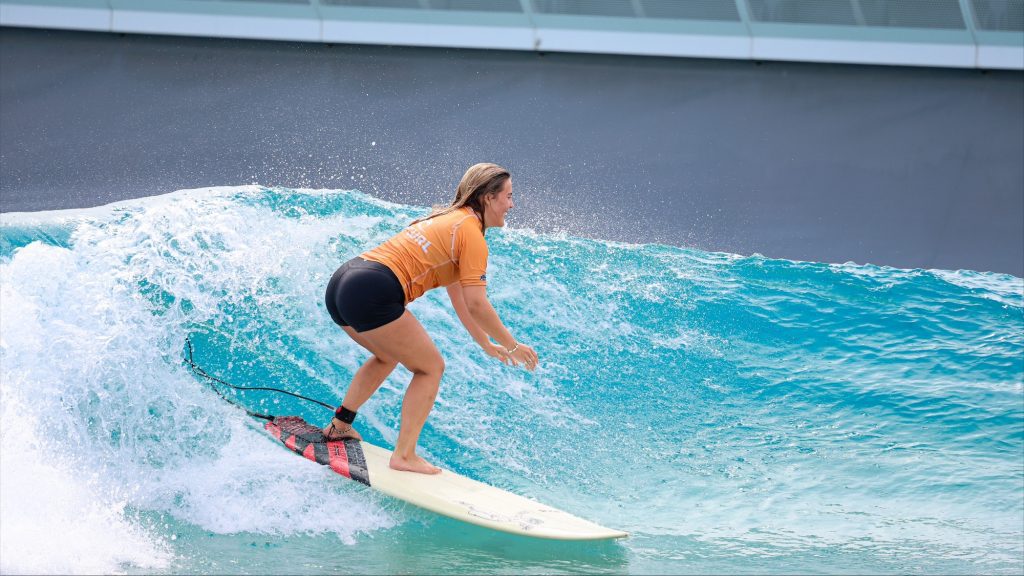
Seams and straps
In short, flat seams are stronger, don’t chafe, and make for a streamlined silhouette. You can check by running your finger along the seam of a suit: if it’s bulging at all, it’s not a flat seam. Flat to the touch, but substantial? You got it.
“Look for good, thick seams – rather than just your flimsy triangle-cheapie that you can pick up for a tenner,” said Morris. “Don’t tend to go for things like that, because that can just break quite easily. Go for quality product [that will last].”
Speaking of triangle-tops: the problem with those in surfing are threefold. First, the string-bottom can chafe against the board and your skin. Secondly, those triangles tend to move back and forth. Thirdly, that tie in the back doesn’t stand a chance in a heavy wipeout.
Ultimately, the type of strap you seek out will depend on individual bodies and bust sizes. But generally, said Morris, “we tend to stock slightly thicker straps because with surfing in a wave pool, it feels like more of a sport activity than just like a leisure [activity].
“You you don’t want to have to worry about your swimming costume coming down, or if it’s going to be too revealing. Sometimes it’s more about functional than style for surfing. But it’s good when you can find one that does both, that looks good, but also works well.”
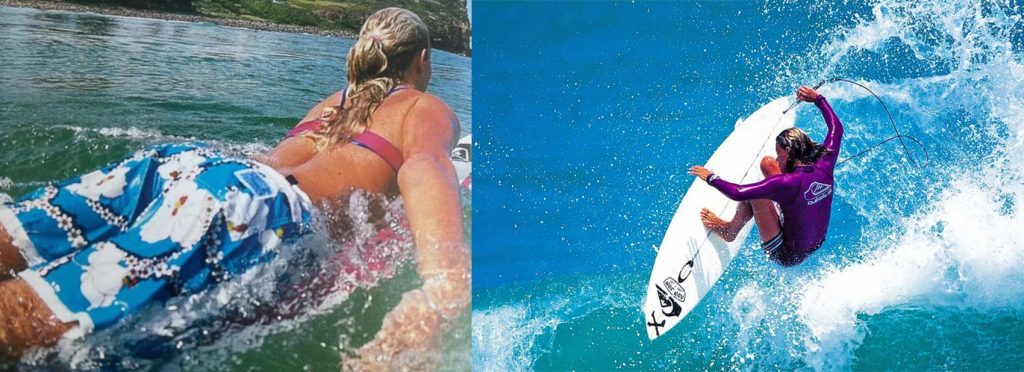
Staying put
In other words, a suit that stays on – even in a tumble – is everything. It’s for that reason that some people prefer full suits – also known as maillots or bathing costumes – and, sometimes, surf trunks. It was four-time American champion Lisa Andersen who essentially dreamt up the first surf trunk for women in the ‘90s. The concept not only revolutionized comfort for women in the surf lineup, but also made millions for her longtime sponsor, Roxy.
At The Wave Bristol, women’s surf trunks are summer essentials for the lifeguards and surf coaches, in particular.
“They give you the ease of movement that you need for surfing when you’re popping up, but you don’t just have to wear them in the pool,” said Morris. Some staff and visitors also opt for tighter versions in a boy-short cut, which offer more coverage than a bathing suit or bikini bottom, but still hug the derrière and upper thighs, for a functional, bodycon cut.
Ultimately, said Morris, once you’ve found a suit with key comfort, quality, and doesn’t-budge features, the rest is about personal preference and fit.
“We find that because it’s more a sporting thing here where people come to train, and because you’re constantly going around in that hour, a little bit of warmth and more security [are key]. You want stuff that will do you well whilst you’re surfing here.”
Related Coverage
